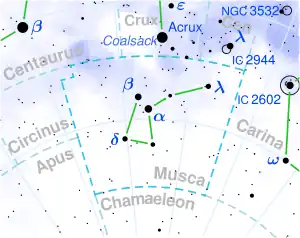HD 102839
| Observation data Epoch J2000 Equinox J2000 | |
|---|---|
| Constellation | Musca |
| Right ascension | 11h 49m 56.61541s[1] |
| Declination | −70° 13′ 32.8408″[1] |
| Apparent magnitude (V) | 4.98[2] |
| Characteristics | |
| Spectral type | G6Ib[3] |
| U−B color index | +1.22[4] |
| B−V color index | +1.40[4] |
| Astrometry | |
| Radial velocity (Rv) | +15.90[5] km/s |
| Proper motion (μ) | RA: −8.113[1] mas/yr Dec.: −0.834[1] mas/yr |
| Parallax (π) | 2.1101±0.1063 mas[1] |
| Distance | 1,550 ± 80 ly (470 ± 20 pc) |
| Absolute magnitude (MV) | −2.33[2] |
| Details | |
| Mass | 2.3[6] M☉ |
| Radius | 78[1] R☉ |
| Luminosity | 1,593[2] L☉ |
| Surface gravity (log g) | 0.63[6] cgs |
| Temperature | 4,500[7] K |
| Metallicity [Fe/H] | −0.34[6] dex |
| Rotational velocity (v sin i) | 7.6[8] km/s |
| Other designations | |
| CPD−69°1595, FK5 2945, GC 16206, GSC 09230-02344, HIP 57696, HR 4538, HD 102839, SAO 251604 | |
| Database references | |
| SIMBAD | data |
HD 102839 is a class G6Ib (yellow supergiant) star in the constellation Musca. Its apparent magnitude is 4.98 and it is approximately 1,550 light years away from Earth based on parallax.
References
- ^ a b c d e f Vallenari, A.; et al. (Gaia collaboration) (2023). "Gaia Data Release 3. Summary of the content and survey properties". Astronomy and Astrophysics. 674: A1. arXiv:2208.00211. Bibcode:2023A&A...674A...1G. doi:10.1051/0004-6361/202243940. S2CID 244398875. Gaia DR3 record for this source at VizieR.
- ^ a b c Anderson, E; Francis, Ch (2012). "XHIP: An extended hipparcos compilation". Astronomy Letters. 38 (5): 331. arXiv:1108.4971. Bibcode:2012AstL...38..331A. doi:10.1134/S1063773712050015. S2CID 119257644. Vizier catalog entry
- ^ Hoffleit, D; Warren, W. H (1995). "VizieR Online Data Catalog: Bright Star Catalogue, 5th Revised Ed. (Hoffleit+, 1991)". VizieR On-line Data Catalog: V/50. Originally Published in: 1964BS....C......0H. 5050. Bibcode:1995yCat.5050....0H.
- ^ a b Mallama, A (2014). "Sloan Magnitudes for the Brightest Stars". The Journal of the American Association of Variable Star Observers. 42 (2): 443. Bibcode:2014JAVSO..42..443M.Vizier catalog entry
- ^ Gontcharov, G. A (2006). "Pulkovo Compilation of Radial Velocities for 35 495 Hipparcos stars in a common system". Astronomy Letters. 32 (11): 759–771. arXiv:1606.08053. Bibcode:2006AstL...32..759G. doi:10.1134/S1063773706110065. S2CID 119231169.
- ^ a b c Anders, F.; Khalatyan, A.; Chiappini, C.; Queiroz, A. B.; Santiago, B. X.; Jordi, C.; Girardi, L.; Brown, A. G. A.; Matijevic, G.; Monari, G.; Cantat-Gaudin, T. (2019-08-01). "Photo-astrometric distances, extinctions, and astrophysical parameters for Gaia DR2 stars brighter than G = 18". Astronomy and Astrophysics. 628: A94. arXiv:1904.11302. Bibcode:2019A&A...628A..94A. doi:10.1051/0004-6361/201935765. ISSN 0004-6361.
- ^ McDonald, I; Zijlstra, A. A; Boyer, M. L (2012). "Fundamental parameters and infrared excesses of Hipparcos stars". Monthly Notices of the Royal Astronomical Society. 427 (1): 343–357. arXiv:1208.2037. Bibcode:2012MNRAS.427..343M. doi:10.1111/j.1365-2966.2012.21873.x. S2CID 118665352. Vizier catalog entry
- ^ Glebocki, R; Gnacinski, P (2005). "VizieR Online Data Catalog: Catalog of Stellar Rotational Velocities (Glebocki+ 2005)". VizieR On-line Data Catalog. 3244. Bibcode:2005yCat.3244....0G. Vizier catalog entry
